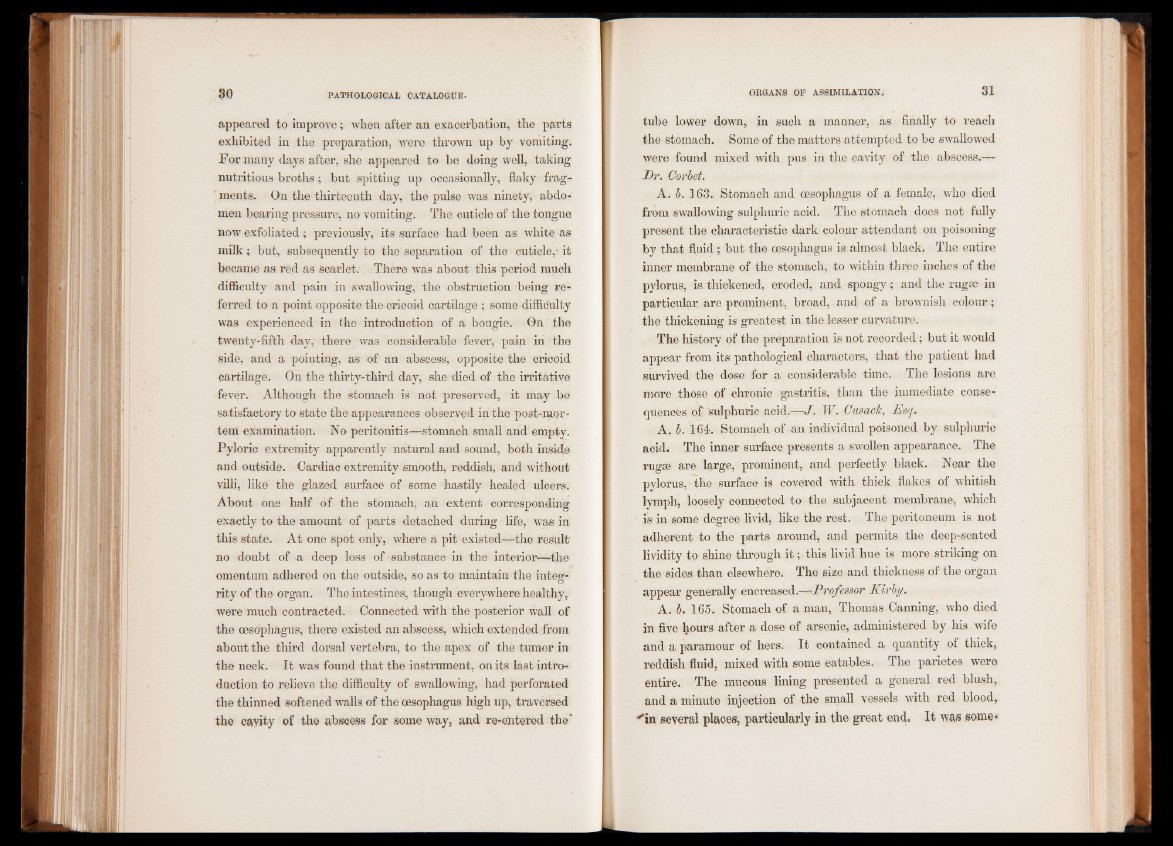
appeared to improve; when after an exacerbation, the parts
exhibited in the preparation, were thrown up by vomiting.
For many days after, she appeared to be doing well, taking
nutritious broths; but spitting up occasionally, flaky fragments.
On the thirteenth day, the pulse wTas ninety, abdomen
bearing pressure, no vomiting. The cuticle of the tongue
now exfoliated; previously, its surface had been as white as
milk; but, subsequently to the separation of the cuticle,; it
became as red as scarlet. . There was about this period much
difficulty and pain in swallowing, the obstruction being referred
to a point opposite the cricoid cartilage ; some difficulty
was experienced in the introduction of a bougie. On the
twenty-fifth day, there was considerable fever, pain in the
side, and a pointing, as of an abscess, opposite the cricoid
cartilage. On the thirty-third day, she died of the irritative
fever. Although the stomach is not preserved, it may.be
satisfactory to state the appearances observed in the post-mortem
examination. No peritonitis—stomach small and empty.
Pyloric extremity apparently natural and sound, both inside
and outside. Cardiac extremity smooth, reddish, and without
villi, like the glazed surface of some hastily healed ulcers.
About one half of the stomach, an extent corresponding
exactly to the amount of parts detached during life, was in
this state. At one spot only, where a pit existed—the result
no doubt of a deep loss of substance in the interior—the
omentum adhered on the outside, so as to maintain the integrity
of the organ. The intestines, though everywhere healthy,
were much contracted. Connected with the posterior wall of
the oesophagus, there existed an abscess, which extended from
about the third dorsal vertebra, to the apex of the tumor in
the neck. It was found that the instrument, on its last introduction
to relieve the difficulty of swallowing, had perforated
the thinned softened walls of the oesophagus high up, traversed
the cavity of the abscess for some way, and re-entered the'
tube lower down, in such a manner, as finally to reach
the stomach. Some of the matters attempted to be swallowed
were found mixed with pus in the cavity of the abscess.—
Dr. Corbet.
A. b. 163. Stomach and oesophagus of a female, who died
from swallowing sulphuric acid. The stomach does not fully
present the characteristic dark colour attendant on poisoning
by that fluid; but the oesophagus is almost black. The entire
inner membrane of the stomach, to within three inches of the
pylorus, is thickened, eroded, and spongy; and the rugae in
particular, are prominent, broad, and of a brownish colour;
the thickening is greatest in the lesser curvature.
The history of the preparation is not recorded; but it would
appear from its pathological characters, that the patient had
survived the dose for a considerable time. The lesions are
more those of chronic gastritis, than the immediate consequences.
of' sulphuric acid.—J. W. Cusack, Esq.
A. b. 164. Stomach of an individual poisoned by sulphuric
acid. The inner surface presents a swollen appearance. The
rugae are large, prominent, and perfectly black. Near the
pylorus, the surface is covered with thick flakes of whitish
lymph; loosely connected to the subjacent membrane, which
is in some degree livid, like the rest. The peritoneum is not
adherent to the parts around, and permits the deep-seated
lividity to shine through it; this livid hue is more striking on
the sides than elsewhere. The size and thickness of the organ
appear generally encreased.—Professor Kirby.
A. b. 165. Stomach of a man, Thomas Canning, who died
in five fcours after a dose of arsenic, administered by his wife
and a paramour of hers. It contained a quantity of thick,
reddish fluid, mixed with some eatables. The parietes were
entire. The mucous lining presented a general red blush,
and a minute injection of the small vessels with red blood,
•'’in several places, particularly in the great end. It was some